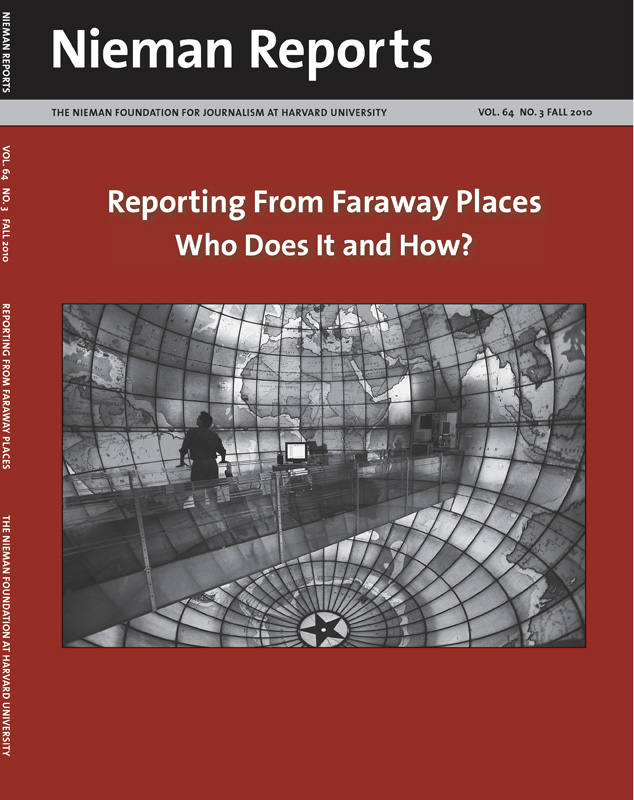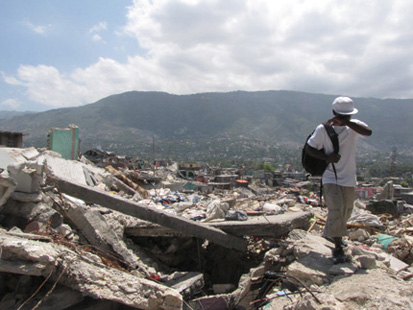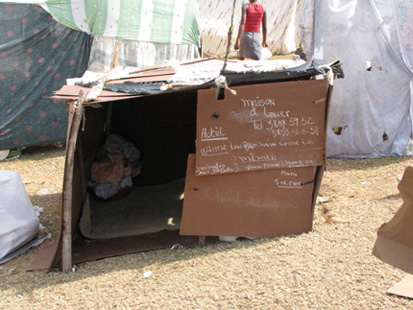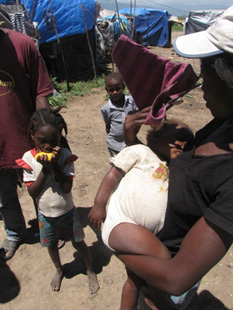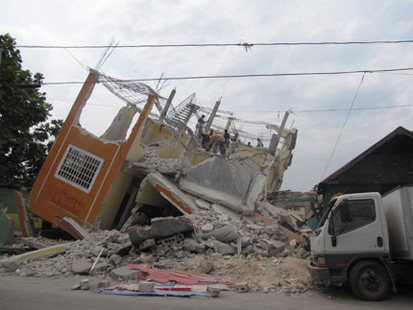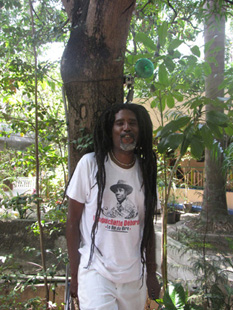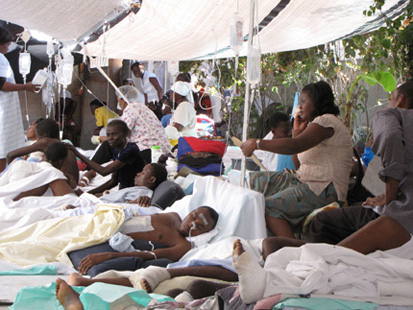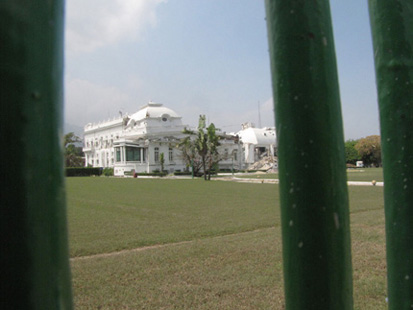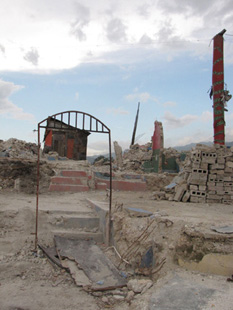One afternoon in June, I was sitting in my car at a red light in downtown Port-au-Prince, when I saw, out of the corner of my eye, a begging hand reaching toward my window. I hate being hit up at stoplights. I hate being honked at when the light turns green as I’m reaching for change. I hate worrying that I’m going to run over someone’s foot as he pushes up against my car.
I waved the begging hand away. But when the light changed and I began to ease forward, I saw that the man was in a wheelchair, his legs severed. And the wheelchair was one of those cheap, white plastic deck chairs, connected by bent metal rods to bicycle wheels. I gasped.
I had heard about a Haitian wheelchair factory in the metal artisan town of Croix-des-Bouquets. They made cheap, funky, creative wheelchairs, I was told. In my mind, the factory represented the kind of Haitian innovation that springs from a lack of resources to meet desperate needs. I had wanted to find that factory. I had called government people, disability organizations, and United Nations humanitarian groups. I had driven around Croix-des-Bouquets and factory districts around Port-au-Prince, asking random people on the street. No luck.
Now, seeing the begging man, I knew these chairs existed. I wended my way through the streets and returned to the stoplight. By then he had left but merchants on the sidewalk said they had seen someone pushing him down the hill. I drove until I spotted them, parked the car, and pursued on foot. But they disappeared into the crowd. I asked everyone I saw on the street if they had seen the man in the wheelchair. After deliberation and debate, fingers pointed through another intersection and around a park. I got back in my car and followed, circling, searching and finding nothing. They were gone. I felt crushed.
I would think about that man in that wheelchair for the next 24 hours, replaying what had happened and wondering what I should have done differently in my pursuit. How could I have been so slow? When I considered recounting this story to friends, I hesitated. Who would sympathize with a foreign journalist who only cared about a needy legless man because he could help her with a feature story? I wondered if journalism had skewed my sense of what mattered.
Meanwhile I kept thinking about the man, wondering not only where he had gotten his wheelchair, but other things: where he lived and how old he was, who was pushing him around, how he had lost his legs, how much money he made begging, if he had another source of income, if he would get any help from nongovernmental organizations coming into the country. I thought about the back pain I get after sitting too long in an uncomfortable chair. It struck me that that wheelchair might hurt like hell.
Finally, it struck me that it was the journalist in me that was asking all these questions. My instinct had been to wave the man away, but my profession had taught me to pursue what I sometimes want to avoid. A vague story idea had triggered a determination to understand more. What I had missed wasn’t just the chance to do a quirky radio piece, it was an opportunity to learn something about the man in the wheelchair.
Arriving in Haiti
Learning about people’s dramatically different lives was a reason that I started thinking about foreign reporting when I graduated from college in 1997, and it was why I moved to Haiti after journalism school in 2003. Haiti was known on the outside as a land of coups d’état, chaos and poverty. I wanted to understand what these circumstances actually meant to the people living there.
I never imagined how long it would take for this to happen. During the past seven years, I have spent a total of some 30 months in Haiti, and I still struggle to fathom the things I see, hear and experience. When I first set out for Haiti, a friend told me, “In Haiti, believe nothing of what you hear and only some of what you see.” I followed this advice if only because I couldn’t wrap my mind around much of what was happening around me.
During a period of violence that followed the ouster of President Jean-Bertrand Aristide, a nice-looking young man pointed to a beheaded corpse in the road and proudly took credit for it. I nodded and wrote in my notebook. After floods and landslides that killed several hundred people in the spring of 2004, residents of a devastated village told me they had just lost all of their children, and I nodded and wrote in my notebook.
While I was accumulating plenty of material for articles, I was having a very hard time comprehending that any of this was anyone’s reality.
Spending enough time in a tormented country for the reality to truly sink in is a painful experience. It also becomes increasingly challenging to write about a place you’re getting to know quite well for an audience that knows nothing about it. For Reuters and then The Associated Press (AP), my subsequent employer, this meant finding ways to succinctly explain what Haiti is and what it is going through.
I found out that I am not cut out for wire services. Work with them forced me onto the frontlines of important events, but I did not thrive under the tight control by bosses in another country, the always-yesterday deadlines, and the quick-and-dirty reporting style. There was no time for the reality of what I was experiencing to penetrate or percolate.
I left AP to try my hand at full-time freelancing for magazines and newspapers. But that reality came as a bit of a shock. I kept thinking that my phone wasn’t working. It nearly stopped ringing after I left AP to strike out on my own. The AP had barred me from freelancing while I worked for them so moonlighting gigs I had while working for Reuters and The Haitian Times were by now forgotten.
There were other factors, including bad timing when it came to Americans’ interest in news from Haiti. Focus had rapidly shifted elsewhere. Haiti had no coups or major natural disasters then. Gang fighting was limited to certain slums, and elections happened without any major violence. Meanwhile wars were raging in the Middle East, and New Orleans was under water. What’s more, there was suddenly far less space and money for international news. Though I was still fascinated by Haiti, and I had the time to pursue the stories I had been unable to do with the AP, the takers were few and paid little. I was frighteningly underemployed.
I returned home to Boston and moved in with my mother. I holed myself up in my room with a computer for days, applying to fellowships and jobs. The outcome: An offer for a night cops reporting position at a paper in a small town where the police responded to calls about graffiti and, at least once, “a suspicious seagull.”
But I also began to identify outlets that seemed to be bucking the trend away from quality international news reporting. The Christian Science Monitor not only wanted features, but it also was looking for “positive” stories about Haiti. World Vision Report wanted richly textured and detailed pieces about life in other countries. Inter Press Service paid little but had an almost endless interest in the Caribbean and a new budget for stories on women’s issues.RELATED ARTICLE
“Connecting Correspondents with Broadcasters”
– Henry Peirse Global Radio News (GRN) was there with broadcast contacts around the world should anything arise in Haiti. Random glossies, like Marie Claire and the Argentinean edition of Alma Magazine, would occasionally bite.
Through all of this, mediabistro.com, the online resource for freelancers, helped me identify outlets and figure out how to pitch to them.
I finally discovered Public Radio International’s “The World” based at WGBH in Boston. Like so many other news programs, “The World” struggles with budget constraints, and it’s hard to get a job there in part because turnover is so low. But after waiting around for opportunities and pestering them for years, I’ve been able to report for them from Haiti and do freelance production work in their Boston newsroom. From the latter I’ve learned that it’s possible to do stimulating international journalism, even in the United States.
Returning to Haiti
Almost six months after the devastating earthquake, I returned to Haiti to report for “The World.” It was my third trip to the country since the tragedy struck in January. And it’s still—or maybe increasingly—painful to see the destruction all around. Perhaps even harder is seeing the problems that existed in Haiti since well before the earthquake. Somehow one had hoped that all the international attention—all the donations after the earthquake—might have brought some modicum of positive change.
Traffic is chaotic, and driving dangerous, as it always has been. For that reason, too many people lost limbs, if not their lives, even before the earthquake. And with or without such handicaps, more children and adults were begging on the streets in the months before the earthquake than I had seen in previous years. Now the number has multiplied. The deeply entrenched problems of poverty, corruption and lawlessness are hard to be around, and almost impossible for me to absorb. I still feel I have a choice: I can nod my head and passively record the cries for help; or I can fight through the pain involved in truly grasping the human dimensions of all that I am seeing and hearing and ask questions and make real, in whatever ways I can, people’s experiences for those listening back home.
Mostly, I am trying to do the latter, but I can’t do it all the time. So I take short trips to Haiti and go back home to process, relax and recover. As of this fall, I am a student again, at the Fletcher graduate school of international affairs at Tufts University, in part to find new ways to understand what I’ve seen in Haiti. It’s hard to know where this path will take me, but I can’t imagine ever completely leaving journalism behind.
I know I’ll be returning to Haiti. Maybe I’ll see the man in the wheelchair again, and if I do, I don’t know if I’ll wave him away or chase him down. Even though I’ll likely be burnt out on suffering, maybe I’ll have the courage to ask what life is like for him. I might think I already know the answer, but just as likely I’d discover that I don’t, that the world doesn’t, and that that’s why I’m here, to find out.
One thing Haiti has taught me is to try to resist shutting out the suffering I find around me and to ask about it, try to understand it, and do whatever I can to help my audience to care. That’s why I love my job—but it’s also why I hate it.
Amy Bracken is a freelance journalist who splits her time between Boston and Port-au-Prince.


